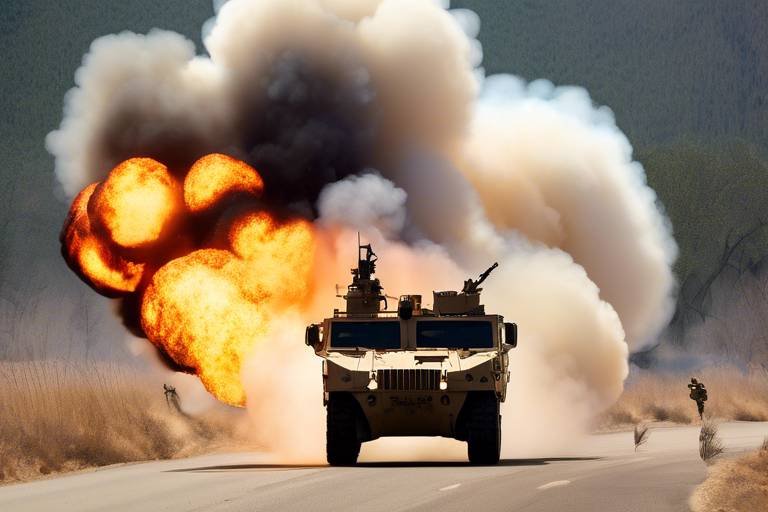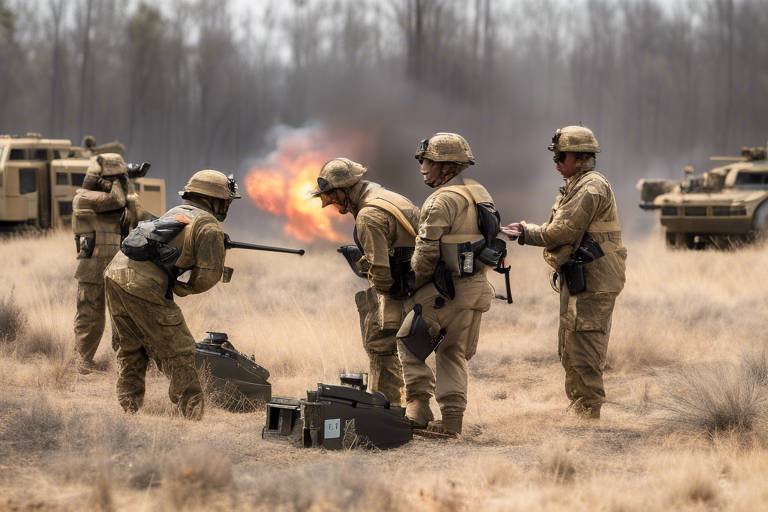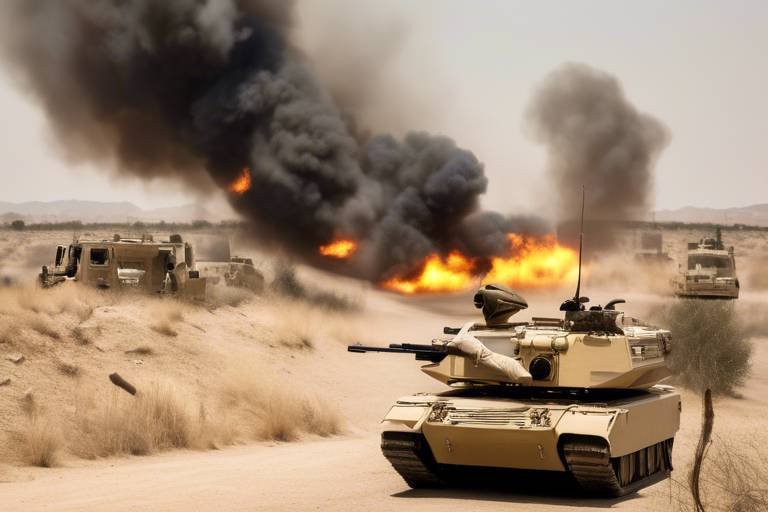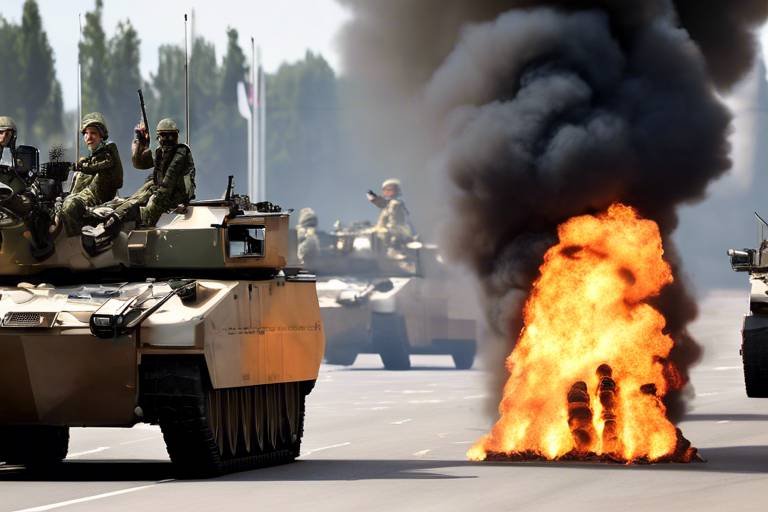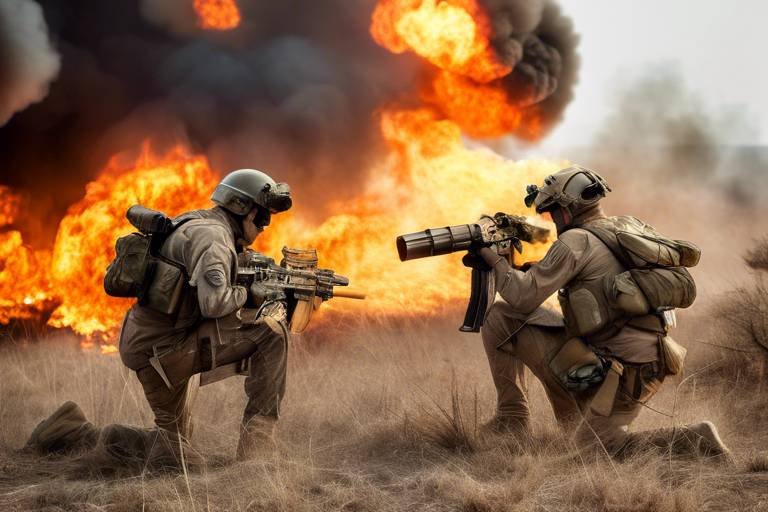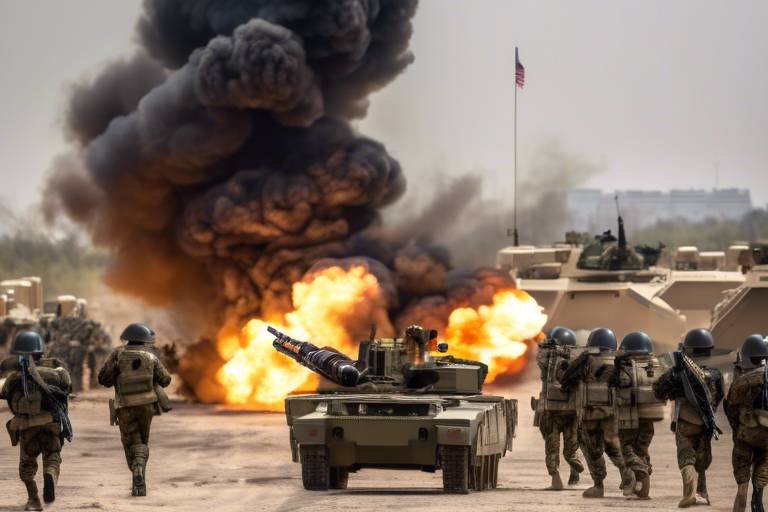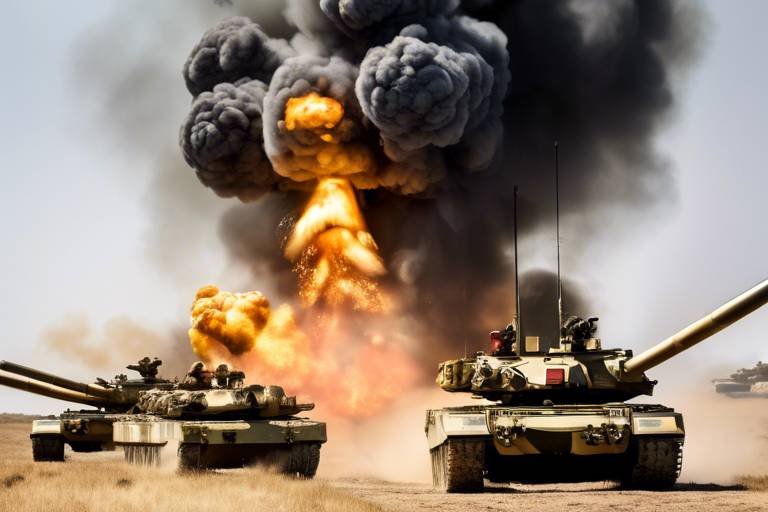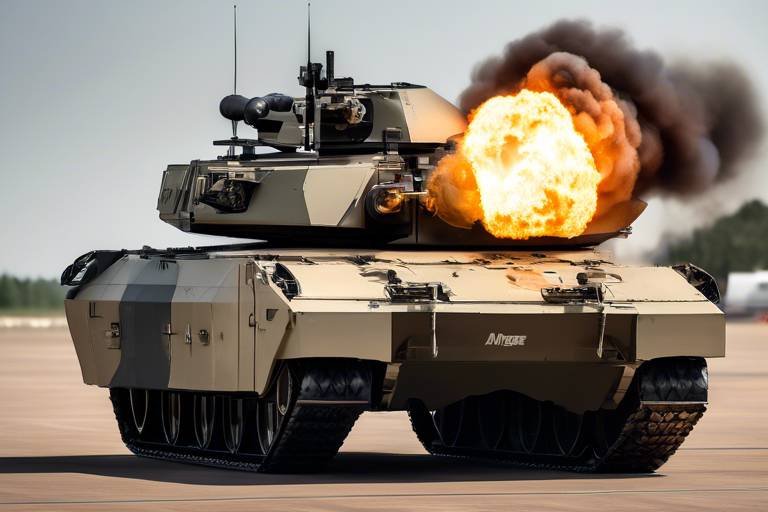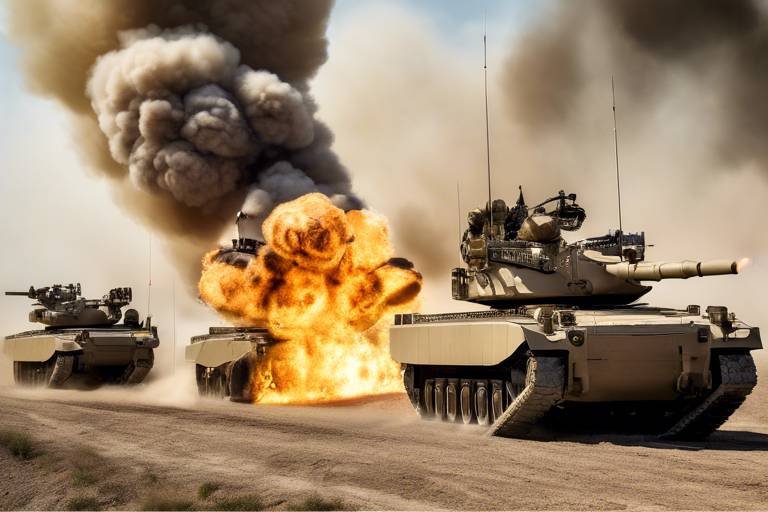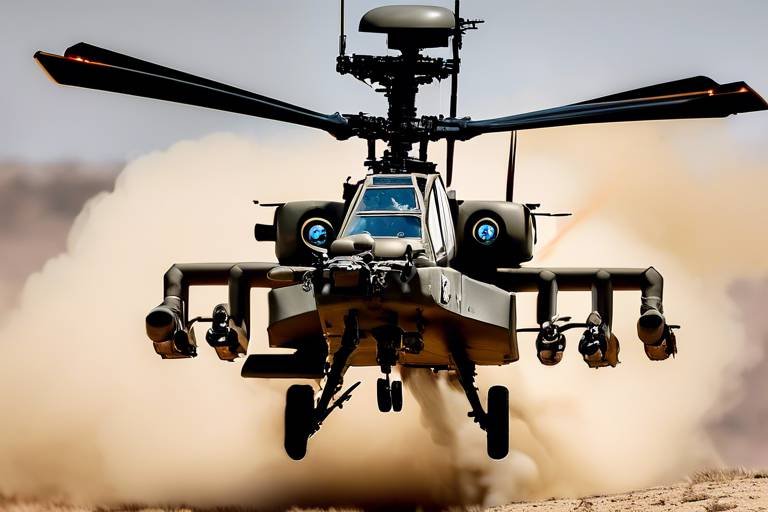How Firepower Shapes National Security Policies
In today's world, the concept of firepower transcends mere weaponry; it embodies the very essence of national security strategies. Understanding how military capabilities influence decision-making, international relations, and overall security landscapes is essential for grasping the complexities of modern geopolitics. The interplay between a nation's military strength and its security policies often determines not just its survival, but its standing on the global stage. Have you ever wondered how a single missile launch can shift the balance of power? Or how a country’s defense budget can dictate its diplomatic relationships? This article delves into the intricate relationship between firepower and national security policies, revealing the profound implications of military capabilities in shaping our world.
To truly appreciate the role of firepower in national security, we must first explore its historical evolution. From the invention of gunpowder to the modern-day advancements in precision-guided munitions, military technology has continuously evolved, reshaping the dynamics of warfare and diplomacy. Key milestones include:
- Gunpowder Era: Revolutionized battlefield tactics and led to the rise of powerful empires.
- World Wars: Introduced mechanized warfare and aerial combat, changing the scale of conflict.
- Nuclear Age: Brought about a new understanding of deterrence and global power balance.
Each of these advancements not only changed how wars were fought but also influenced national security policies. Countries began to realize that possessing cutting-edge firepower could deter potential aggressors and enhance their global standing. As military capabilities expanded, so did the complexity of international relations, with nations constantly recalibrating their strategies to maintain a competitive edge.
Deterrence remains a cornerstone of national security, and the effective use of firepower is central to this concept. Nations leverage their military capabilities to deter potential aggressors, ensuring stability in volatile regions. The mere presence of advanced weaponry can serve as a powerful message to adversaries: think twice before taking aggressive actions. But how does this play out in reality?
Nuclear weapons represent the pinnacle of firepower, and their existence has drastically shaped international relations. The doctrine of nuclear deterrence hinges on the idea that the threat of catastrophic retaliation will prevent adversaries from launching an attack. This delicate balance of power has led to a complex web of alliances and enmities that defines today's geopolitical landscape.
The doctrine of Mutually Assured Destruction (MAD) is a critical aspect of nuclear strategy. It posits that if two opposing sides possess the capability to destroy each other with nuclear weapons, neither will initiate conflict. This grim reality has kept the peace between nuclear powers for decades, but it also raises questions about the long-term sustainability of such a precarious balance. What happens if a rogue state enters the equation?
The rise of new nuclear states complicates the security landscape even further. As more nations acquire nuclear capabilities, the potential for miscalculation and conflict increases. The challenges posed by nuclear proliferation are immense, affecting international stability and prompting nations to rethink their security policies. How do established nuclear powers respond to this changing dynamic?
While nuclear weapons often grab headlines, conventional forces play a vital role in modern conflicts. The rise of asymmetrical warfare—where smaller, less-equipped forces engage in conflict against more powerful adversaries—has altered traditional security policies. Nations must now consider unconventional tactics and the implications of non-state actors in their national security strategies.
The balance of firepower significantly influences diplomatic relations. Military capabilities can serve as both a deterrent and a bargaining chip in negotiations. Countries with superior firepower often find themselves in a position of strength, able to dictate terms in international discussions. This dynamic is evident in military alliances, where shared capabilities can enhance collective security.
Military alliances are frequently formed based on shared firepower capabilities. For instance, NATO members collectively enhance their security through mutual defense agreements, pooling resources and intelligence. Such alliances shape national security strategies, ensuring that member states can respond effectively to threats. The question remains: how do these alliances adapt to evolving security challenges?
Regional conflicts often highlight the role of firepower in shaping security policies. For example, the ongoing tensions in the Middle East demonstrate how military capabilities can escalate conflicts and complicate diplomatic efforts. Analyzing specific case studies reveals the intricate dynamics at play, showcasing how firepower influences not only military outcomes but also political negotiations.
Q: How does firepower influence national security policies?
A: Firepower shapes national security policies by acting as a deterrent against potential aggressors, influencing diplomatic relations, and determining military strategies.
Q: What is nuclear deterrence?
A: Nuclear deterrence is a strategy that relies on the threat of nuclear retaliation to prevent adversaries from launching an attack.
Q: How do alliances affect military strategies?
A: Alliances enhance collective security by pooling military capabilities and resources, allowing member states to respond more effectively to threats.
The Evolution of Firepower
Understanding the historical development of firepower is crucial in analyzing its impact on national security. From the early days of hand-held weapons to the sophisticated technology we see today, firepower has undergone a remarkable transformation. Imagine a time when a simple bow and arrow determined the outcome of battles; now, we have precision-guided munitions and drones that can strike targets with incredible accuracy from thousands of miles away. This evolution has not only changed how wars are fought but has also reshaped the very fabric of international relations.
In the ancient world, firepower was primarily defined by the effectiveness of infantry and cavalry. The introduction of gunpowder in the 9th century marked a significant turning point, leading to the development of cannons and firearms. This new form of firepower shifted the balance of power and allowed nations to project military strength over greater distances. As a result, the concept of warfare evolved, leading to the rise of empires and the expansion of territories.
Fast forward to the 20th century, and we see the emergence of mechanized warfare during World War I. The introduction of tanks and aircraft changed the battlefield dynamics, making it clear that conventional tactics were no longer sufficient. The devastation of World War II further pushed nations to innovate, leading to the development of nuclear weapons. The sheer destructive capability of nuclear arms introduced a new era of deterrence and forced countries to reconsider their security strategies.
Today, we stand at the crossroads of traditional and asymmetric warfare. The rise of non-state actors and cyber warfare has added complexity to the security landscape. Countries now invest heavily in cyber capabilities, recognizing that firepower is not just about physical weapons but also about information dominance. This evolution of firepower has led to a more intricate web of alliances and conflicts, as nations navigate the challenges posed by both conventional and unconventional threats.
To illustrate the evolution of firepower, consider the following table that highlights key milestones in military technology:
| Era | Key Advancements | Implications for National Security |
|---|---|---|
| Ancient | Hand-held weapons, Bows and arrows | Localized conflicts, Limited range |
| Medieval | Cannons, Gunpowder | Rise of empires, Greater territorial expansion |
| World War I | Tanks, Aircraft | Mechanized warfare, New strategies |
| Cold War | Nuclear weapons | Deterrence, Global power dynamics |
| Modern Era | Cyber warfare, Drones | Asymmetrical conflicts, Information warfare |
As we analyze the evolution of firepower, it's clear that each advancement has not only affected military strategies but has also influenced national security policies. Nations are now more interconnected than ever, and the implications of firepower extend beyond borders. Understanding this evolution helps us appreciate the complexities of modern security challenges and the ongoing quest for stability in an unpredictable world.
- What is firepower? Firepower refers to the capability of a military to deliver force against an enemy, which includes weaponry, technology, and tactics.
- How has firepower evolved over time? Firepower has evolved from simple weapons to advanced technologies such as nuclear weapons and cyber capabilities, significantly changing warfare and international relations.
- What role does firepower play in national security? Firepower is crucial for deterrence, defense strategies, and shaping diplomatic relations between nations.
Firepower and Deterrence Strategies
When we talk about national security, one of the most pivotal concepts that come into play is deterrence. But what does it really mean? At its core, deterrence is about preventing aggression by showcasing the capability and willingness to respond with overwhelming force. Nations invest heavily in building their military capabilities not just for defense but as a way to send a clear message to potential aggressors: "Think twice before you act!" This relationship between firepower and deterrence strategies is intricate and multifaceted, influencing everything from diplomatic negotiations to military alliances.
To truly grasp how firepower shapes deterrence, we need to consider a few key factors. First, the perception of threat plays a critical role. If a nation believes that it is under threat from another, it will likely enhance its military capabilities to deter any potential aggression. This can lead to an arms race, where countries continuously build up their firepower in response to each other’s military advancements. Such dynamics can escalate tensions, creating a cycle of fear and mistrust that complicates international relations.
Moreover, the effectiveness of deterrence is not solely based on the quantity of firepower available. The credibility of a nation’s military capabilities is equally important. For instance, a country may possess a large arsenal of weapons, but if its leaders are perceived as unwilling to use them, the deterrent effect diminishes. This is where the psychological aspect of deterrence comes into play—how nations communicate their resolve and readiness to act can significantly influence the behavior of other states.
Another fascinating aspect of firepower and deterrence is the role of technology. In today’s world, advancements in military technology have transformed the landscape of deterrence strategies. For example, the development of cyber warfare capabilities introduces a new dimension to national security. A nation can launch a cyberattack that disrupts critical infrastructure without firing a single shot, thus deterring adversaries through means that were unimaginable just a few decades ago. This evolution challenges traditional notions of deterrence and requires nations to adapt their strategies accordingly.
In summary, firepower is not just about having the most weapons; it’s about how nations utilize that firepower to craft effective deterrence strategies. The interplay between military capabilities, perception of threats, credibility, and technological advancements creates a complex web that shapes the security landscape. As we delve deeper into the topic, we will explore specific examples of how these strategies manifest in real-world scenarios.
- What is deterrence in national security?
Deterrence is a strategy aimed at preventing aggression by demonstrating the capability and willingness to respond with overwhelming force. - How does firepower influence deterrence?
Firepower influences deterrence by showcasing a nation’s military capabilities, which can discourage potential aggressors from taking hostile actions. - What role does technology play in modern deterrence strategies?
Technological advancements, such as cyber warfare capabilities, have transformed deterrence strategies, allowing nations to deter threats through means beyond traditional military force.
Nuclear Deterrence
is a cornerstone of modern military strategy, and it represents the ultimate expression of firepower in the realm of national security. The idea is simple yet profound: possessing nuclear weapons can prevent adversaries from taking aggressive actions, as the consequences of a nuclear retaliation would be catastrophic. This concept has shaped international relations since the dawn of the nuclear age, influencing not only the policies of nuclear-armed states but also the strategies of those without such capabilities. It's like a high-stakes game of chess, where the threat of losing everything keeps players in check.
The balance of power is crucial here. When one nation develops or enhances its nuclear arsenal, it can trigger a ripple effect, prompting other nations to bolster their own defenses. This dynamic creates an atmosphere of tension and competition, often referred to as an arms race. For instance, during the Cold War, the United States and the Soviet Union engaged in a fierce competition to outdo each other in nuclear capabilities, leading to the development of increasingly sophisticated weapons systems. The question arises: how do nations navigate this treacherous landscape?
One of the most significant doctrines that emerged from nuclear deterrence is the principle of Mutually Assured Destruction (MAD). This doctrine posits that if two opposing sides possess the capability to destroy each other completely, neither side will initiate conflict for fear of mutual annihilation. While this may sound like a recipe for peace, it is fraught with complexities. The fear of escalation and miscalculation can lead to tense standoffs, where a single misstep might trigger a catastrophic response.
The implications of nuclear deterrence extend beyond military strategy; they seep into the fabric of international diplomacy. Countries often engage in arms control negotiations to limit the proliferation of nuclear weapons, aiming to reduce the risks associated with these powerful arsenals. Treaties like the Non-Proliferation Treaty (NPT) serve as frameworks for cooperation and dialogue, but the effectiveness of such agreements is constantly tested by geopolitical shifts and the emergence of new nuclear states.
As we look to the future, the landscape of nuclear deterrence is evolving. The rise of new nuclear powers poses significant challenges to global stability. Nations like North Korea and India have developed nuclear capabilities, complicating the traditional power dynamics and raising questions about the effectiveness of deterrence strategies. In this new era, the concept of deterrence must adapt to include cyber warfare, ballistic missile defense, and other technological advancements that can alter the effectiveness of nuclear arsenals.
In conclusion, nuclear deterrence remains a pivotal factor in shaping national security policies. It is a delicate balance of power, fear, and diplomacy that can either lead to peace or plunge the world into chaos. As nations continue to navigate this complex terrain, understanding the nuances of nuclear deterrence will be essential for maintaining stability in an increasingly unpredictable world.
- What is nuclear deterrence? Nuclear deterrence is a military strategy that aims to prevent aggression by threatening retaliatory nuclear strikes.
- How does the doctrine of MAD work? The doctrine of Mutually Assured Destruction posits that if two nuclear-armed states engage in conflict, both will face total annihilation, thus deterring them from initiating war.
- What are the risks of nuclear proliferation? Nuclear proliferation increases the number of states with nuclear capabilities, raising the potential for conflict and complicating international relations.
Mutually Assured Destruction
The doctrine of (MAD) is a cornerstone of nuclear strategy that has profoundly influenced global peace and security since the Cold War era. At its core, MAD posits that if two opposing sides possess the ability to completely destroy each other with nuclear weapons, then neither side will initiate conflict, as the consequences would be catastrophic for both. This precarious balance of terror creates a unique form of stability, ensuring that nations are deterred from engaging in direct military confrontation. It's as if both sides are standing on the edge of a cliff, knowing that a push could lead to mutual annihilation. The fear of total destruction acts as a powerful motivator for maintaining peace, albeit a peace that is built on a foundation of fear.
One of the key implications of MAD is the necessity for both sides to maintain a credible second-strike capability. This means that even if one nation were to launch a surprise attack, the other must possess enough firepower to respond effectively, ensuring that both parties are aware that the consequences of any aggression would be dire. This dynamic creates a delicate dance of military preparedness and diplomatic negotiations, where every move is calculated and analyzed. The presence of nuclear arsenals leads to a situation where nations are forced to engage in complex strategies that involve not only military readiness but also psychological warfare, as they seek to project strength while avoiding escalation.
However, the doctrine of MAD is not without its criticisms. Detractors argue that relying on the threat of total destruction is an unstable and dangerous strategy. The potential for miscommunication, accidents, or rogue actors to trigger a nuclear exchange raises serious concerns about the viability of MAD as a long-term security strategy. Moreover, as new nuclear states emerge and existing powers modernize their arsenals, the landscape of nuclear deterrence becomes increasingly complicated. In this context, the risk of nuclear proliferation poses a significant challenge to the original tenets of MAD, as more players enter the game with varying levels of restraint and capability.
In summary, while the doctrine of has played a pivotal role in shaping international relations and maintaining a fragile peace, it also presents a host of challenges and risks that must be navigated carefully. The balance of power that MAD creates is akin to walking a tightrope; one misstep could lead to a fall that impacts not just the nations involved, but the entire world. As we look to the future, understanding the implications of this doctrine will be essential in crafting effective national security strategies that prioritize stability and peace.
- What is Mutually Assured Destruction (MAD)?
MAD is a military strategy that asserts if two opposing sides both possess nuclear weapons capable of destroying each other, neither side will initiate conflict, as it would lead to total annihilation. - How does MAD contribute to global stability?
By ensuring that both sides are deterred from initiating a conflict due to the fear of catastrophic consequences, MAD creates a precarious balance of power that can prevent war. - What are the risks associated with MAD?
The reliance on MAD carries risks such as miscommunication, potential accidents, and the involvement of rogue states or actors that may not adhere to the same deterrent logic. - How has nuclear proliferation affected MAD?
The emergence of new nuclear states complicates the MAD framework, as different nations may have varying levels of restraint and military capabilities, increasing the risk of conflict.
Modern Nuclear Proliferation
Nuclear proliferation has become a significant concern in today's global landscape, as the number of nations pursuing nuclear capabilities continues to rise. Unlike the Cold War era, where the nuclear club was relatively small and tightly controlled, the modern age has witnessed a surge in interest from various states, driven by a mix of security concerns, regional rivalries, and technological advancements. As countries seek to bolster their security through nuclear arsenals, the implications for international stability and peace become increasingly complex.
At the heart of this issue lies the question: what motivates nations to pursue nuclear weapons? The reasons are varied and often intertwined. For many, the possession of nuclear arms is seen as a deterrent against external threats. Countries like North Korea, for example, view their nuclear capabilities as essential to their national defense strategy, ensuring that potential aggressors think twice before launching an attack. Conversely, nations such as Iran are often accused of seeking nuclear weapons under the guise of civilian nuclear energy programs, raising alarms among their neighbors and the global community.
Moreover, the technological advancements in nuclear weapons have made it easier for countries to develop and maintain their arsenals. The proliferation of knowledge and materials has created a scenario where even smaller nations can aspire to join the ranks of nuclear powers. This shift not only complicates the security landscape but also challenges existing non-proliferation treaties and agreements designed to curb the spread of nuclear weapons. The Non-Proliferation Treaty (NPT), established in 1968, aimed to prevent the spread of nuclear weapons and promote disarmament. However, its effectiveness is continually tested by states that either refuse to sign or choose to violate its terms.
As we delve deeper into modern nuclear proliferation, it’s essential to consider the potential consequences. The rise of new nuclear states can lead to:
- Increased Tensions: New nuclear powers can heighten regional tensions, prompting neighboring countries to enhance their military capabilities as a countermeasure.
- Arms Races: The emergence of additional nuclear states may trigger arms races, as countries strive to match or exceed their rivals' firepower.
- Security Dilemmas: Nations may find themselves in security dilemmas, where defensive measures are perceived as aggressive actions, leading to further escalations.
In conclusion, modern nuclear proliferation presents a multifaceted challenge to global security. As nations navigate the complex interplay of ambition, fear, and technological capabilities, the international community must remain vigilant. The consequences of unchecked proliferation could be dire, making it imperative for diplomatic efforts to address these challenges head-on. Only through cooperation and dialogue can we hope to mitigate the risks associated with a world where nuclear weapons are more accessible than ever.
- What is nuclear proliferation? Nuclear proliferation refers to the spread of nuclear weapons and technology to nations that do not currently possess them.
- Why do countries pursue nuclear weapons? Countries pursue nuclear weapons for various reasons, including national security, regional power dynamics, and political leverage.
- What are the risks of nuclear proliferation? The risks include increased regional tensions, arms races, and potential conflicts that could escalate into nuclear war.
- How does the Non-Proliferation Treaty work? The NPT aims to prevent the spread of nuclear weapons, promote peaceful uses of nuclear energy, and advance global disarmament efforts.
Conventional Forces and Asymmetrical Warfare
In the ever-evolving landscape of modern conflict, the interplay between conventional forces and asymmetrical warfare has become increasingly significant. Conventional forces, typically characterized by large armies, advanced weaponry, and organized military strategies, represent the traditional approach to warfare. However, the rise of asymmetrical warfare, where smaller, less-equipped groups engage in conflict against larger, more powerful forces, has dramatically altered the dynamics of national security policies. This shift is not just a tactical change; it challenges the very foundations of how nations perceive and respond to threats.
Asymmetrical warfare often involves unconventional tactics such as guerrilla warfare, cyber attacks, and terrorism. These methods are designed to exploit the vulnerabilities of conventional forces, making it difficult for traditional military strategies to succeed. For instance, a small insurgent group can leverage their knowledge of local terrain and social dynamics to launch surprise attacks, disrupting the operations of a much larger military force. This kind of warfare forces nations to reconsider their military doctrines and adapt their strategies to address these unconventional threats.
One of the primary reasons asymmetrical warfare has gained traction is the increasing accessibility of technology. With the proliferation of advanced technology, even non-state actors can acquire tools that enhance their combat effectiveness. For example, the use of drones and cyber capabilities allows smaller groups to conduct operations that can have significant impacts on larger military forces. This technological democratization has led to a rethinking of what constitutes military power and how it can be effectively wielded in conflict.
Moreover, the psychological aspect of asymmetrical warfare cannot be overlooked. The ability of a smaller force to inflict damage and create fear among a larger, conventional military can lead to a significant shift in public perception and political will. This is particularly evident in conflicts where the local population may support insurgents, viewing them as liberators rather than aggressors. As a result, conventional forces must not only focus on military victories but also on winning the hearts and minds of the local populace.
As nations grapple with these challenges, they must also consider how to integrate their conventional forces with strategies that address asymmetrical threats. This often involves a combination of military, diplomatic, and economic measures. For instance, counterinsurgency operations aim to restore stability and build trust within communities, while also dismantling the operational capabilities of insurgent groups. The complexity of these operations underscores the need for a multifaceted approach to national security.
To further illustrate the distinctions between conventional forces and asymmetrical warfare, the following table summarizes key differences:
| Aspect | Conventional Forces | Asymmetrical Warfare |
|---|---|---|
| Size | Large, organized military units | Smaller, often decentralized groups |
| Strategy | Direct engagement and large-scale operations | Guerrilla tactics, sabotage, and psychological warfare |
| Technology | Advanced weaponry and equipment | Utilizes low-tech solutions and adaptable strategies |
| Objectives | Territorial control and dominance | Undermine morale and create instability |
In conclusion, the relationship between conventional forces and asymmetrical warfare is complex and continually evolving. As nations strive to adapt to these changing dynamics, understanding the implications of these two forms of conflict is essential for shaping effective national security policies. The future of warfare may not solely depend on the size of an army or the sophistication of its technology, but rather on the ability to innovate and respond to the unpredictable nature of modern threats.
- What are conventional forces? Conventional forces refer to large, organized military units that utilize traditional warfare tactics and advanced weaponry.
- What is asymmetrical warfare? Asymmetrical warfare involves conflict between opposing forces with significant differences in military power or strategy, often utilizing unconventional tactics.
- How has technology influenced warfare? The accessibility of advanced technology has allowed smaller groups to engage effectively against larger conventional forces, changing the nature of conflict.
- Why is winning hearts and minds important in conflict? Gaining the support of the local population can significantly impact the success of military operations and the overall stability of a region.
Firepower in International Relations
When we talk about firepower in international relations, we’re diving into a fascinating world where military capabilities not only dictate the strength of a nation but also shape the very fabric of global diplomacy. Imagine firepower as a chess piece on a grand board, where each move can alter the balance of power and influence. The presence of robust military forces often serves as a deterrent against potential aggressors, and this dynamic plays a pivotal role in how nations interact with one another.
Countries with significant firepower tend to wield greater influence on the global stage. This influence can manifest in various ways, such as forming alliances, engaging in military cooperation, or even asserting dominance in regional conflicts. For instance, the United States, with its extensive military capabilities, often finds itself at the center of international negotiations, using its firepower as leverage to secure favorable outcomes. In contrast, nations with limited military resources may struggle to assert their interests, leading to an uneven playing field in diplomatic engagements.
One of the most compelling aspects of firepower in international relations is its role in shaping alliances. Nations often band together based on shared military capabilities, forming coalitions that can enhance their collective security. These alliances are not merely about mutual defense; they also reflect a strategic calculation of how firepower can be pooled to deter threats. For example, NATO (North Atlantic Treaty Organization) is a prime example of an alliance where member states benefit from the combined military strength of the group, reinforcing the idea that strength in numbers can lead to greater stability.
However, the dynamics of firepower are not always straightforward. Regional conflicts often reveal the complexities of military capabilities in shaping security policies. Take the Middle East, for instance, where various nations possess differing levels of firepower, leading to an intricate web of alliances and hostilities. Countries like Iran and Israel, both with significant military assets, frequently engage in a precarious balance of power, where each side’s firepower influences its diplomatic maneuvers. Such situations highlight how firepower can escalate tensions, complicating peace efforts and leading to prolonged conflicts.
Moreover, the rise of emerging powers has added another layer of complexity to international relations. As nations like China and India bolster their military capabilities, they challenge the existing power structures, prompting a reevaluation of alliances and security strategies. This shift often leads to a reactive approach from established powers, who must adapt to the changing landscape of firepower. In this context, firepower becomes not just a tool for defense but also a means of asserting influence and negotiating power.
In conclusion, the interplay between firepower and international relations is a dynamic and ever-evolving phenomenon. As nations continue to invest in their military capabilities, the implications for diplomacy, alliances, and global stability will remain profound. Understanding this relationship is crucial for policymakers and analysts alike, as it provides insights into the motivations behind state actions and the potential for conflict or cooperation on the world stage.
- What is the significance of firepower in international relations? Firepower plays a crucial role in shaping diplomatic relations, influencing alliances, and deterring potential aggressors.
- How do military alliances affect national security? Military alliances enhance collective security by pooling resources, which can deter threats and provide a stronger negotiating position in international affairs.
- What role do emerging powers play in the dynamics of firepower? Emerging powers challenge existing power structures, prompting established nations to reassess their security strategies and alliances.
Alliances and Military Cooperation
In the intricate tapestry of global politics, alliances and military cooperation stand as vital threads that weave together nations in shared objectives and mutual defense. These alliances are not merely formal agreements; they are dynamic partnerships that evolve based on the shifting sands of international relations and security needs. At their core, these military alliances are often formed on the foundation of shared firepower capabilities, where nations recognize that their collective strength can serve as a formidable deterrent against potential aggressors.
Take, for instance, the North Atlantic Treaty Organization (NATO), a prime example of how military cooperation can enhance national security. Established in 1949, NATO was primarily a response to the perceived threat from the Soviet Union. Over the decades, it has adapted to new challenges, emphasizing the importance of collective defense. Article 5 of the NATO treaty states that an armed attack against one member is considered an attack against all, which underscores the notion that unity in firepower can significantly deter hostile actions. This principle of collective security not only enhances the military capabilities of member states but also fosters a sense of international stability.
Furthermore, alliances can facilitate the sharing of military technology and intelligence, which is crucial in modern warfare. For example, the Five Eyes alliance—comprising Australia, Canada, New Zealand, the United Kingdom, and the United States—exemplifies how nations can cooperate to enhance their intelligence-gathering capabilities. This partnership allows for the rapid dissemination of critical information, enabling member states to respond more effectively to threats. The sharing of advanced military technologies can also level the playing field for smaller nations, allowing them to enhance their defense capabilities without the need for extensive military expenditures.
However, the formation of alliances is not without its challenges. Nations must navigate complex political landscapes, balancing national interests with collective goals. There can be tensions within alliances, especially when member states have differing military capabilities or strategic priorities. For instance, the varying levels of commitment to defense spending among NATO members have sparked debates about burden-sharing and the effectiveness of the alliance. Such disparities can lead to friction and may even jeopardize the unity that these alliances strive to maintain.
Moreover, the rise of new military powers and non-state actors has further complicated the landscape of alliances and military cooperation. Countries like China and Russia are expanding their influence, prompting traditional powers to reassess their security strategies. New alliances are emerging, often characterized by regional cooperation and joint military exercises. These shifts highlight the necessity for nations to remain adaptable and responsive to the evolving threats in the global arena.
In conclusion, alliances and military cooperation are essential components of national security strategies. They not only enhance the firepower of individual nations but also contribute to broader global stability. As the geopolitical landscape continues to change, the ability of nations to forge strong partnerships and collaborate on defense will be crucial in addressing the multifaceted challenges of modern warfare.
- What is the primary purpose of military alliances?
Military alliances are primarily formed to enhance collective security and deter potential aggressors through shared military capabilities. - How do alliances adapt to changing global threats?
Alliances adapt by reassessing their strategic priorities, engaging in joint military exercises, and sharing intelligence and technology among member states. - What challenges do military alliances face?
Challenges include differing national interests, disparities in military capabilities, and the emergence of new powers that may alter the balance of power.
Regional Conflicts and Firepower Dynamics
When we think about regional conflicts, it's crucial to recognize that firepower plays a pivotal role in shaping the outcomes of these disputes. Conflicts are not just about territorial disputes or political disagreements; they are often heavily influenced by the military capabilities that each party brings to the table. Take, for example, the ongoing tensions in the Middle East. Countries like Iran and Israel have engaged in a high-stakes game of firepower, where military advancements and strategic alliances dictate the flow of power. This dynamic creates a precarious balance where even minor incidents can escalate into larger confrontations, impacting not just the nations involved but also their allies.
One of the most telling aspects of these conflicts is how nations use their firepower to project strength and deter adversaries. For instance, during the Syrian Civil War, various factions have relied on foreign military support to bolster their firepower, significantly altering the conflict's trajectory. The involvement of countries like Russia and the United States has not only provided these factions with advanced weaponry but has also introduced new tactics and strategies into the battlefield. As a result, the conflict has become a complex web of alliances and hostilities, where firepower dynamics are constantly shifting.
Moreover, regional conflicts often reveal the underlying motivations behind military build-ups. Nations may invest in their military capabilities not only to defend against external threats but also to assert their influence within their region. For instance, the arms race in South Asia between India and Pakistan is a clear demonstration of how firepower can be perceived as a means of national pride and security. Both countries have engaged in a continuous cycle of military enhancements, driven by historical animosities and the desire to maintain a strategic edge over one another.
In addition to traditional military forces, the rise of asymmetrical warfare has transformed how firepower is utilized in regional conflicts. Non-state actors, such as terrorist organizations, often employ unconventional tactics that challenge the conventional military might of nation-states. This evolution has forced countries to rethink their security strategies, leading to a greater emphasis on intelligence, surveillance, and counter-terrorism operations. The ongoing conflict in Afghanistan serves as a prime example, where the Taliban's guerrilla tactics have proven effective against more technologically advanced military forces.
Understanding the intricate relationship between firepower and regional conflicts requires a comprehensive analysis of historical and contemporary case studies. For instance, examining the Israeli-Palestinian conflict reveals how firepower dynamics influence peace negotiations. Each side's military capabilities often dictate the terms of engagement and the willingness to compromise, making it challenging to achieve lasting peace. The cycle of violence and retaliation can perpetuate a state of conflict, where firepower is both a tool of defense and a means of aggression.
In conclusion, the dynamics of firepower in regional conflicts are complex and multifaceted. As nations continue to navigate these turbulent waters, the implications of military capabilities on national security policies cannot be overstated. The interplay between traditional military strength and asymmetrical tactics will shape the future of international relations, making it essential for policymakers to remain vigilant and adaptable in the face of evolving threats.
- What role does firepower play in regional conflicts?
Firepower serves as a critical factor in determining the outcomes of regional conflicts, influencing military strategies, alliances, and negotiations. - How do non-state actors impact firepower dynamics?
Non-state actors use asymmetrical warfare tactics that challenge traditional military powers, forcing nations to adapt their security strategies accordingly. - Can firepower lead to peace?
While firepower can deter aggression, it often complicates peace negotiations, making it difficult to achieve lasting resolutions to conflicts.
Frequently Asked Questions
- What is the significance of firepower in national security?
Firepower is crucial in shaping national security policies as it influences decision-making and strategic planning. Nations with advanced military capabilities often have greater leverage in international relations, allowing them to deter potential threats and maintain stability.
- How has firepower evolved over time?
The evolution of firepower includes significant advancements in military technology, from traditional weaponry to modern nuclear arms. These developments have transformed global power dynamics, making it essential for nations to adapt their security strategies to remain competitive.
- What role does nuclear deterrence play in international relations?
Nuclear deterrence is a key factor in maintaining global peace. The presence of nuclear weapons can prevent conflicts, as countries are less likely to engage in warfare when the consequences could be catastrophic. This delicate balance is often maintained through doctrines like Mutually Assured Destruction (MAD).
- What is Mutually Assured Destruction (MAD)?
MAD is a doctrine that asserts that the full-scale use of nuclear weapons by two or more opposing sides would result in the total annihilation of both the attacker and the defender. This concept has been pivotal in shaping nuclear strategy and ensuring a precarious peace among nuclear-armed states.
- How does modern nuclear proliferation affect global security?
The rise of new nuclear states complicates the security landscape, as it introduces new players into the nuclear arena. This proliferation can lead to increased tensions and instability, challenging existing security frameworks and necessitating new diplomatic approaches.
- What is the impact of conventional forces on modern conflicts?
Conventional forces remain vital in modern warfare, but the rise of asymmetrical tactics has changed the nature of conflicts. Nations must adapt their security policies to address unconventional threats, which often include non-state actors and guerrilla warfare strategies.
- How do alliances influence national security strategies?
Military alliances are formed based on shared firepower capabilities, which can enhance collective defense. These alliances shape national security strategies by providing mutual support and deterring potential aggressors, creating a more stable security environment.
- Can you provide examples of regional conflicts influenced by firepower?
Regional conflicts often highlight the dynamics of firepower in shaping security policies. For instance, tensions in the Middle East and Eastern Europe illustrate how military capabilities can escalate conflicts and influence diplomatic negotiations.

